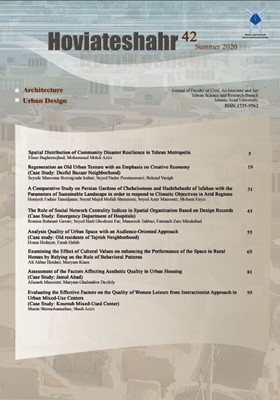نقش شاخصهای مرکزیت شبکههای اجتماعی در سازماندهی فضایی مبتنی بر سوابق طراحی (مطالعه موردی: بخش اورژانس بیمارستانها)
الموضوعات :رمیصاء رحمتی گواری 1 , هادی قدوسی فر 2 , منصوره طاهباز 3 , فاطمه زارع میرکآباد 4
1 - دانش آموخته دکترى معمارى، گروه معمارى، واحد تهران جنوب، دانشگاه آزاد اسلامى، تهران، ایران.
2 - استادیار گروه معمارى، واحد تهران جنوب، دانشگاه آزاد اسلامى، تهران، ایران
3 - دانشیار، دانشکدۀ معماری و شهرسازی، دانشگاه شهید بهشتی، تهران، ایران.
4 - استادیار، دانشکدۀ ریاضی و علوم کامپیوتر، دانشگاه صنعتی امیرکبیر، تهران، ایران.
الکلمات المفتاحية: نحوفضا, شاخص مرکزیت, شبکه اجتماعی, سوابق طراحی, نظریۀ گراف,
ملخص المقالة :
سازماندهی فضایی، مرحلهای بسیار حائز اهمیت بهخصوص در طراحی پلانهای کارکردی است. جهت سازماندهی کارکردی نیاز است فضاها بهدرستی جانمایی شوند. معماران در مراحل مختلف طراحی از سوابق طراحی بهره میبرند. فرض اصلی این پژوهش مبتنی بر این موضوع است که میتوان از سوابق طراحی، شاخصهای لازم برای ارزیابی روابط فضایی پلان را در مرحله برنامهریزی معماری استخراج نمود. هدف اصلی پژوهش بهکارگیری دانش موجود در سوابق طراحی جهت ارزیابی سازماندهی فضایی پیش از اجرا و پس از بهرهبرداری است. جهت انجام پژوهش 60 پلان اورژانس بیمارستان بهعنوان جامعۀ آماری (سوابق طراحی) انتخاب شدند. شاخصهای مرکزیت بینیت و نزدیکی برای تمامی حوزههای موجود در سوابق طراحی توسط نرمافزار سایتواسکیپ محاسبه شدند. تمرکز اصلی پژوهش بر سازماندهی عملکردی اصلیترین حوزۀ درمانی اورژانس (حوزۀ فوریت) قرارگرفته است. با محاسبۀ این شاخصها مشخص شد که حوزۀ فوریت باید به نحوی سازماندهی شود که بالاترین مرکزیت بینیت و نزدیکی را داشته باشد.
اکسنر، اولریخ؛ و پرسل، دتریش. (1395). مفاهیم پایه در طراحی فضا. (شادی عزیزی و صفورا اولنج، مترجمان). تهران: کتاب فکرنو.(نشر اثر اصلی 2009)
پناهی، سیامک؛ هاشمپور، رحیم؛ و اسلامی، غلامرضا. (1393). معماری اندیشه، از ایده تا کانسپت. هویت شهر، 8(17)، 25-34.
غریبپور، افرا. (1392). اصطلاحشناسی عملکرد معماری. نشریه هنرهای زیبا. 18(1)، 59-72.
لاوسون، برایان. (1395). طراحان چه میدانند. (حمید ندیمی، فرهاد شریعتراد، فرزانه باقیزاده، مترجمان). چاپ اول. تهران: انتشارات دانشگاه شهید بهشتی.
محمودی، سیدامیرسعید؛ و ذاکری، سیدمحمدحسین. (1390). استخراج دانش کاربردی از پیشینهها و تأثیر آن بر خلاقیت در طراحی معماری. نشریه هنرهای زیبا، 3 (47)، 39-50.
Akin,O. (1986). Psychology of architectural design. London: Pion.
Ashby, M., & Johnson, K. (2002). Materials and Design. (3thed.). Oxford: Butterworth Heinemann.
Beauchamp, M. A. (1965). An improved index of centrality. Behavioral Science. 10, 161-163.
Bhatta, S., Goel, A., & Prabhakar, S. (1994). Innovation in Analogical Design: A Model Based Approach In J. Gero & F. Sudweeks (Eds.), Artificial Intelligence in Design ,94. August, (pp. 57-74). Lausanne, Switzerland.
Boling, E., & Gray, C. M. (2018). Use of Precedent as a Narrative Practice in Design. In B. Hokanson, G. Clinton, & K. Kaminiski (Eds.) Educational Technology and Narrative: Story and Instructional Design. (pp. 259-270). Switzerland.
Borgatti, P. (2005). Centrality and Network Flow. Social Networks, 27, 55-71.
Clark, R. H., & Pause, M. (1985). Precedents in architecture. New York: Van Nostrand Reinhold.
Eilouti, B. H. (2009). Design Knowledge Recycling Using Precedent-Based Analysis and Synthesis Models. Design Studies, 30(4), 340-68.
Eilouti, B. (2009). Knowledge Modeling and Processing in Architectural Design.
Freeman, L. (1978). Centrality in Social Networks Conceptual Clarification. Social Networks, 1(3), 215-239.
Grover, R., Emmitt, S., & Copping, A. (2018). The typological learning framework: the application of structured precedent design knowledge in the architectural design studio. International Journal of Technology and Design Education, 28(4), 1019-1038.
Heath, T. (1984). Method in Architecture. Chichester: Wiley.
Jamil, A. (2009). A Model integrating theories of architecture lectures in architectural design studio. Proceedings of the fourth International Conference on architectural education: flexibility in architectural education. May 26-29, (pp.377-391). Turkey: Erciyes University Faculty of Architecture.
Jarvis, P. R. (2016). Improving emergency department patient flow. Clinical and experimental emergency medicine. 3, 63-68.
Kosorukoff, A. (2011). Social Network Analysis:Theory and Applications. Available at:https://www.politaktiv.org/documents/10157/29141/SocNet_TheoryApp.pdf
Lawson, B. (2004). What Designers Know. Oxford: Architectural Press.
Leavitt, H. J. (1949). Some Effects of Certain Communication Patterns on Group Performance. Unpublished Ph.D. Dissertation, Massachusetts Institute of Technology, Cambridge, MA.
Leavitt, H. J. (1951). Some effects of communication patterns on group performance. Journal of Abnormal and Social Psychology, 46, 38-50.
Liu, X., Patacchini, E., Zenou, Y., & Lee, L. (2012). Criminal Networks: Who is the Key Player? working paper. Available at: http://citeseerx.ist.psu.edu/viewdoc/download?doi=10.1.1.394.557&rep=rep1&type=pdf
Loyola, M. (2018). Big data in building design: a review. Journal of Information Technology in Construction (ITcon), 23, 259-284.
Mackenzie, K. D. (1966). The information theoretic entropy function as a total expected participation index for communication network experiments. Psychometrika. (31), 249-254.
Milburn, L., & Brown, R. (2003). The relationship between research and design in landscape architecture, Landscape and Urban Planning, 64 ,47-66.
Morales, C. ( 2014). ArchDaily: Los dos chilenos que conquistaron el mundo -. Forbes Mexico. Available at:http://www.forbes.com.mx/archdaily-los-dos-chilenos-que-conquistaron-el-mundo/
Newman, M. E. J. (2010). Networks:An Introduction. Oxford University press. Available at: http://math.sjtu.edu.cn/faculty/xiaodong/course/Networks%20An%20introduction.pdf
Nourian, P. (2016). Configraphic: Graph Theoretical Methods for Design and Analysis of Spatial Configurations , Unpublished PhD Dissertation, Delft University of Technology.
Oxman, R. (1994). Precedents in design: a computational model for the organization of precedent knowledge, Israel Institute of Technology.
Pitts, F. R. )1965.( A graph theoretic approach to historical geography. The Pofessional Geographer, 17(5), 15-20.
Sabidussi, G. (1966). The centrality index of a graph. Psychometrika, 31(4), 581-603. Available at: https://econpapers.repec.org/article/sprpsycho/v_3a31_3ay_3a1966_3ai_3a4_3ap_3a581-603.htm
Schank, R. (1983). Dynamic Memory:A Theory of Reminding and Learning in Computers and people. Cambridge University Press, Cambridge UK.
Vaughan, L. (2007), The Spatial Syntax of urban segregation, Progress in Planning, 67, 205-294.
Yu, T., Li, M., Wang, J., Pan, Y., & Wu, F.(2015). CytoNCA: A cytoscape plugin for centrality analysis and evaluation of protein interaction networks. BioSystem, 127, 67-72.


